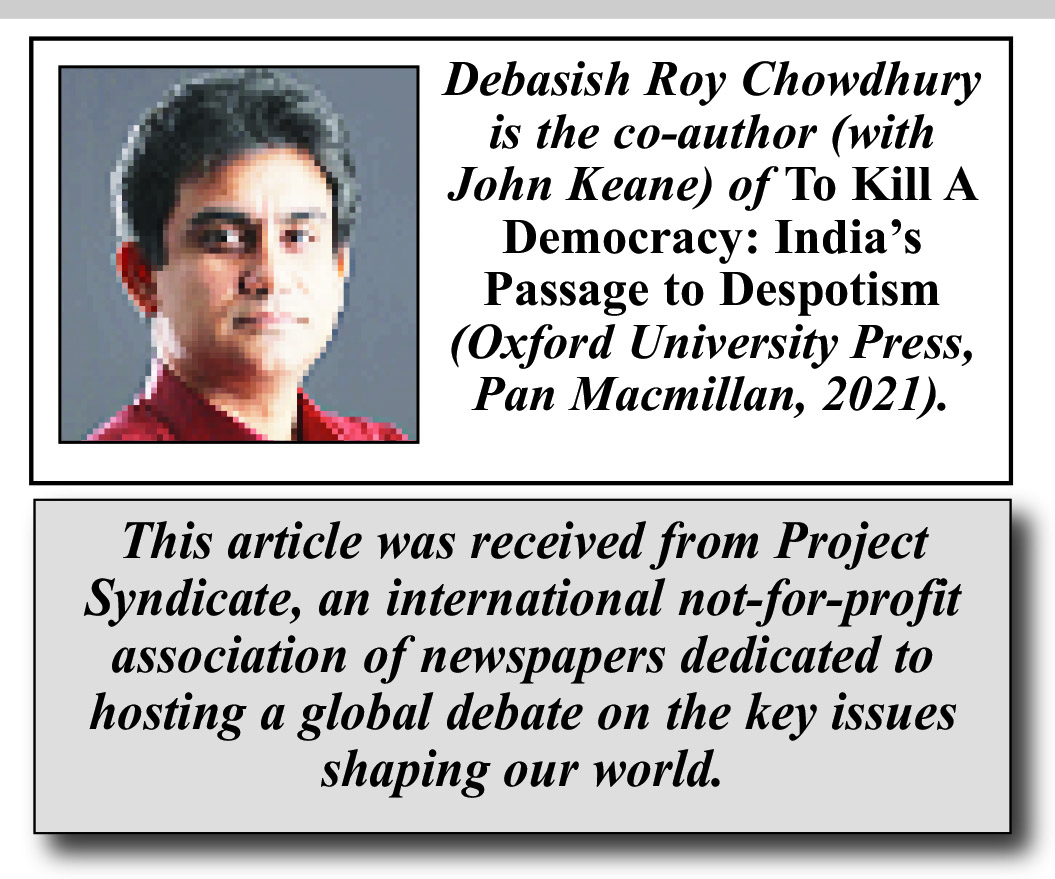HONG KONG – Weeks before his return to the White House, US President-elect Donald Trump issued a pointed warning to the BRICS countries. “Go find another sucker,” he wrote on his social media platform, Truth Social, threatening the group’s nine members with 100% tariffs should they attempt to challenge the dollar’s global dominance.
Trump’s warning came on the heels of his campaign promise to impose a 25% tariff on imported goods from Canada and Mexico on his first day in office. China, the primary target of Trump’s protectionism, is expected to face an additional 10% tariff. While this is hardly surprising, given the escalating trade war between China and the United States, Trump has also directed his ire at India, a founding member of the BRICS and one of America’s key allies.
So far, India has managed to avoid immediate conflict by reaffirming its commitment to the dollar. But such policy uncertainties are among the many reasons why the Indian government has been quietly hedging its bets by pursuing rapprochement with China – a move that could herald a seismic geopolitical shift.
The China-India thaw has become increasingly evident in recent months. In October, the two countries reached an agreement to end the years-long military standoff along their shared Himalayan border, setting the stage for a surprise meeting between Indian Prime Minister Narendra Modi and Chinese President Xi Jinping on the sidelines of the BRICS summit in Kazan, Russia. Another sign of this shift is Indian officials’ newfound interest in attracting Chinese investment.
Meanwhile, US-India relations appear to be cooling. Since a popular uprising ousted Bangladeshi Prime Minister Sheikh Hasina in August, Modi’s favored news outlets, social-media operatives, and Hindu supremacist allies have portrayed the insurrection as a CIA-orchestrated regime change. Some have even warned of similar attempts by the “American deep state” to destabilize India.
Modi’s ruling Bharatiya Janata Party has since embraced anti-American sentiment, accusing the US of targeting Indian tycoon Gautam Adani – a close ally of Modi charged with securities fraud and bribery in the US – in an effort to undermine the Indian government. Such rhetoric, a stark departure from decades of strategic cooperation, evokes memories of the Cold War, when a nominally nonaligned India, wary of US interference, gravitated toward the Soviet Union.
This shift is driven by several factors, primarily America’s diminishing ability and willingness to act as a global leader, along with China and India’s attempts to strengthen their bargaining position. With deglobalization reshaping the world economy, America has less to offer countries like India, which do not entirely rely on it for defense.
By contrast, China’s dominance in global supply chains has become impossible to ignore. As the world’s manufacturing superpower – producing more than the next nine largest manufacturers combined – China could support India’s efforts to expand its own industrial base. The government’s annual economic survey highlighted this imperative, stating that “to boost Indian manufacturing and plug India into the global supply chain,” the country must “plug itself into China’s supply chain.” To this end, the report advocated a pragmatic approach focused on attracting Chinese foreign direct investment (FDI).
Such unequivocal government support for cooperation with China was once unthinkable in India, which has maintained adversarial relations with its neighbor since the 1962 Sino-Indian War. After 20 Indian soldiers were killed in border clashes in India’s Ladakh region in 2020, India responded by imposing sweeping restrictions on investments and imports from China, limiting executive visas, and banning Chinese apps. But these measures resulted in massive losses for Indian businesses reliant on Chinese imports. Worse, they deprived India of critical Chinese investments at a time when FDI inflows were already declining.
As global supply chains shift away from China, Chinese manufacturers are also relocating, establishing bases in countries that stand to benefit from the West’s friendshoring and nearshoring strategies. Chinese investments in greenfield projects tripled year on year in 2023, to $160 billion, with much of these flows going to countries like Vietnam, Indonesia, Hungary, and Serbia. India, grappling with jobless growth and high youth unemployment, is eager to capitalize on this trend.
The US, once a major source of FDI, is now competing with India for investment as it seeks to boost domestic manufacturing. This competition, which is expected to intensify under Trump, has prompted India to approve several investment proposals and offer concessions – including expedited visas – to Chinese businesses and executives.
India’s course correction aligns closely with China’s interests, as the country’s economic slowdown has piqued Chinese firms’ interest in India’s rapidly growing market. India is projected to become the world’s third-largest economy by the end of this decade, and deeper engagement with it would provide China with a major buffer against US efforts to contain its geopolitical rise.
Moreover, while global attention remains focused on the escalating tariff war between the US and China, India faces significant risks of its own. Trump, who has repeatedly labeled India a “very big abuser of tariffs,” had revoked its preferential trade status during his first term, raising the likelihood of further punitive measures.
To be sure, India – designated by the US as a “Major Defense Partner” – is unlikely to abandon its strategic relationship with the US for closer ties with China. But like other emerging powers in the Global South, India is increasingly frustrated with the inherent asymmetry of the US-led liberal international order, particularly the dollar’s hegemony.
These frictions are also fueled by America’s occasional rebukes of India’s treatment of minorities. Having systematically weakened democratic institutions and tightened control over the media, Modi’s government bristles at any international criticism. Fortunately for Modi, such differences may resolve themselves. After all, it’s hard to imagine Trump being overly concerned by India’s ties to Russia, anti-Muslim policies, or democratic backsliding.
Still, as Modi steps up his efforts to transform India into a Hindu state, he may want to secure America’s support by signaling that he has alternatives. In that sense, India’s overtures to China could be viewed as a geopolitical maneuver aimed at enabling India to tell Trump to “go find another sucker” should he decide to play hardball.
Copyright: Project Syndicate, 2025.











